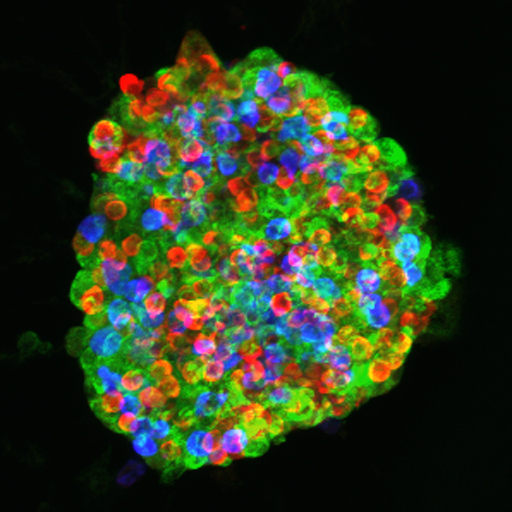Mutant cells and normal neighbors
Most human cancers are thought to arise from mutations in a single cell surrounded by unaffected cells. But current mouse cancer models are inadequate for investigating the interactions between these mutant cells and their unaffected neighbors.
To study these interactions, Sarki Abdulkadir, M.D., Ph.D., and colleagues created a transgenic mouse model with altered expression of c-MYC and Pten – genes implicated in prostate tumorigenesis – in different cells within the same prostate gland.
They show that Pten loss in combination with c-MYC overexpression induces a high-grade prostate cancer. These double mutant cells proliferate faster than cells in the same gland with only a single Pten mutation, despite increased cell death in the double mutant cells. The findings suggest that c-MYC overexpression and Pten deficiency cooperate to promote prostate tumorigenesis. The model, described in the July issue of PLoS Genetics, could provide a way to study the heterogeneous and incremental nature of human prostate carcinogenesis.
— Melissa Marino
Swapping not so easy for transfer RNA
Designing a cell-free system to produce proteins with unnatural amino acids could be a useful resource for developing new drug candidates. But first, researchers must understand what the essential components for protein synthesis (translation) are and how they work.
Anthony Forster, M.D., Ph.D., has assembled a purified synthetic translation system and is using the system to investigate the interchangeability of the various components of transfer RNA (tRNA) – a molecule that recognizes and transfers amino acids to the ribosome where they are assembled into proteins.

The cloverleaf-like structure of tRNA contains one invariant unit and three potentially variable units. Forster investigated the effect of various “swaps” of the three variable regions, but found a low tolerance for altering these components. Doing so reduced the efficiency of the ribosome to incorporate unnatural amino acids – which would be desirable in proteins due to their resistance to degradation. Forster reports these results and proposes potential fixes for the problem in the June issue of Nucleic Acids Research.
— Melissa Marino
Fatty diet sets stage for liver cancer
Obesity and non-alcoholic steatohepatitis – a severe form of fatty liver disease – are risk factors for cirrhosis and liver cancer. To begin to explore the factors that contribute to tumor development in the liver, D. Lee Gorden, M.D., and colleagues studied a mouse model of high-fat diet-induced fatty liver disease.
The investigators showed that mice eating a 42 percent fat diet accumulated fats in their livers and developed features resembling human non-alcoholic fatty liver disease. The fatty-liver mice were more likely to develop primary liver dysplasias (early stage cancers) than normal mice, and they grew more metastatic liver tumors after injection of colon cancer cells into the spleen.

The findings, reported in the July American Journal of Pathology, suggest that signals from the fatty liver microenvironment set the stage for tumor development even in the early treatable stages of fatty liver disease. The model will provide a useful tool for exploring the progression of non-alcoholic fatty liver disease and testing therapeutic agents.
— Leigh MacMillan
Factor key to pancreatic function
The protein Neurog3 plays an essential role in the development of the hormone-secreting islet cells in the pancreas. Expression of Neurog3 in adult islets is considered a marker of “progenitor” cells – cells that will mature into hormone-secreting cells. But it’s not clear if Neurog3 also has roles in “mature” (differentiated) pancreatic cells.
Guoqiang Gu, Ph.D., and colleagues have now used a combination of genetically modified mice, protein and RNA-based assays to examine Neurog3 expression in hormone-expressing islet cells. They report in the June 16 Proceedings of the National Academy of Sciences that differentiated hormone-secreting islet cells continue to express Neurog3 and that inactivating Neurog3 impairs endocrine function.

The findings reveal uncertainties about using Neurog3 as an endocrine progenitor marker in the adult pancreas and demonstrate that Neurog3 is required not only for initiating endocrine cell differentiation, but also for maintaining islet cell function. Neurog3’s role raises the possibility that it could be used therapeutically to boost endocrine islet function in diabetic conditions.
— Leigh MacMillan
We welcome suggestions for research to highlight in Aliquots. The items should be primary research articles (no reviews, editorials or commentaries) published within the last two months in a peer-reviewed journal. Please send the article citation (PDF if available) and any other feedback about the column to: aliquots@vanderbilt.edu.
Past Aliquots
June 22, 2012
June 8, 2012
May 11, 2012
April 27, 2012
April 13, 2012
March 30, 2012
March 16, 2012













